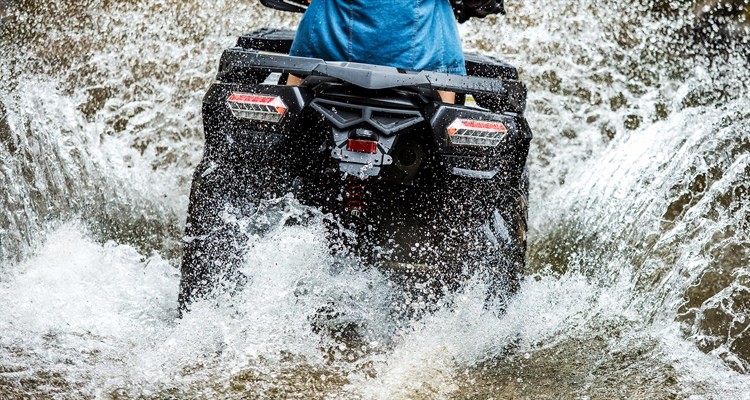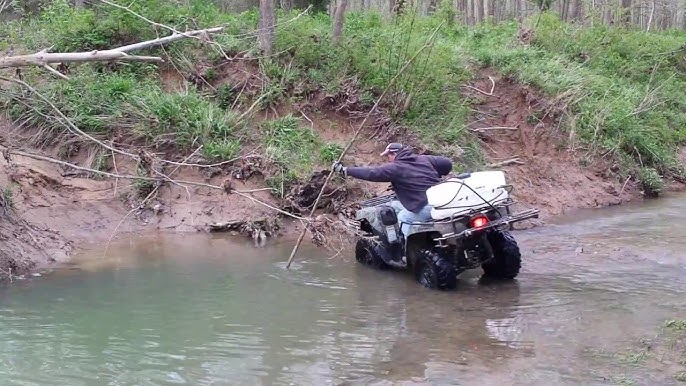Mastering Deep Water Crossings on an ATV
Latest posts
Quad Bike / ATV Specs
Big Boy ATV Specifications
Can-Am ATV Specifications
CFMOTO ATV Specifications
Dinli ATV Specifications
Honda ATV Specifications
Kawasaki ATV Specifications
KAYO ATV Specifications
Kazuma ATV Specifications
Linhai ATV Specifications
Polaris ATV specs
Suzuki ATV Specifications
Yamaha ATV Specifications
ATV Reviews and Comparisons
A Technical Guide To Quad Bike water crossings
Mastering Deep Water Crossings on an ATV: A Technical Guide
Crossing deep water on an Quad Bike (ATV) is a common challenge for off-road enthusiasts, hunters, and utility users navigating rivers, streams, or flooded trails. While ATVs are designed for rugged terrain, water introduces unique risks like engine flooding, loss of traction, and hidden obstacles. Improper technique can lead to hydrolock (water ingestion compressing in the engine cylinder), electrical failures, or even submersion. This technical article draws on established safety guidelines and engineering principles to explain how to assess, prepare, and execute a safe crossing. Always prioritize safety: if in doubt, find an alternative route.

U.S. Army ATV navigating a river crossing, demonstrating gradual entry and controlled speed.
Understanding the Risks: Physics and ATV Limitations
From a technical standpoint, water crossings involve buoyancy, hydrodynamics, and mechanical vulnerabilities. ATVs have a typical ground clearance of 8–12 inches and a fording depth (safe submersion limit) specified in the owner's manual—often no deeper than the footrests (about 12–18 inches for stock models). Exceeding this risks water entering the air intake, exhaust, or CVT (Continuously Variable Transmission) belt housing, causing belt slippage or engine stall.
- Buoyancy and Stability: Water displaces the ATV's weight (Archimedes' principle), reducing tire contact and traction. In depths over half the wheel height, the vehicle can float, leading to loss of control.
- Current Forces: Fast-flowing water exerts hydrodynamic drag (force proportional to velocity squared). Even 1–2 mph currents can push a 700-lb ATV sideways if depth exceeds 1 foot.
- Hidden Hazards: Murky water conceals rocks, drop-offs, or soft beds, which can cause tipping or stuck wheels.
Stock ATVs aren't amphibious; modifications like snorkels (extending air/exhaust intakes) can increase safe depth to 2–3 feet, but they don't eliminate risks.

Adventure rider assessing and crossing a muddy river, highlighting the importance of scouting and steady throttle control.
Pre-Crossing Preparation and Assessment
Before attempting a crossing, conduct a thorough evaluation to minimize dangers.
1. Scout the Crossing
Walk the waterbody if possible (wear waders or boots). Measure depth with a stick—avoid if over footrest level for unmodified ATVs. Check for current speed (drop a leaf and time its travel), entry/exit banks (gradual inclines are ideal), and bottom composition (firm gravel > soft mud).
2. Vehicle Inspection
- Tires and Suspension: Ensure aggressive mud tires (e.g., with deep lugs) for grip; inflate to manufacturer specs (typically 5–7 PSI) to maintain footprint.
- Snorkels and Seals: If installed, verify air intake/exhaust extensions are secure and above anticipated water level. Seal electrical connections with dielectric grease.
- Brakes and Drivetrain: Test differential locks (engage 4WD) and ensure CVT vents are elevated.
- Load and Balance: Remove excess weight; secure cargo high to maintain center of gravity.
3. Personal Gear
Wear a helmet, life jacket (for depths > waist-high), and waterproof boots. Carry recovery tools: winch, tow strap, and a come-along.
If the water is fast-flowing or deeper than 18 inches, reconsider—statistics show water-related ATV incidents account for significant off-road accidents.

ATV navigating a deep muddy river, illustrating the challenges of murky water and the need for cautious assessment.
Execution: Step-by-Step Crossing Technique
Approach crossings methodically, using low-range gearing for torque.
1. Entry
Align perpendicular to the current for stability. Enter slowly (walking speed, 2–5 mph) in 4WD low to maintain momentum without splashing water into intakes. Keep feet on footrests—slippery surfaces increase fall risk.
2. During the Crossing
- Throttle Control: Apply steady, moderate throttle to avoid wheel spin, which digs trenches in soft bottoms. Momentum counters drag, but excessive speed creates bow waves that flood the engine.
- Body Position: Stand slightly if needed for visibility, leaning forward to keep weight over the front wheels for traction. Avoid sudden turns—use differential steering if equipped.
- Depth Management: If water reaches the seat, the ATV may hydroplane; reduce speed and aim for shallower paths. In currents, angle slightly upstream to counteract push.
3. Exit
Accelerate gradually once on firmer ground to clear water from tires and brakes. Test brakes immediately—wet discs reduce stopping power until dried.
For technical precision: Maintain engine RPM above idle (e.g., 1,500–2,000) to prevent stalling from water resistance on the fan or belt.
Post-Crossing Maintenance and Recovery
Water exposure demands immediate care to prevent corrosion or failure.
- Drain and Dry: Park on level ground; remove drain plugs from CVT, differentials, and engine (if applicable) to expel water. Dry brakes by light application while riding.
- Fluid Checks: Inspect oil for milky contamination (emulsification indicates water ingress)—change if needed. Flush and refill if submerged.
- Electrical and Air System: Clean connections; replace wet air filters. Run the engine to evaporate moisture.
- If Stuck: Use a winch anchored to a solid point upstream. Avoid revving in place—it digs deeper. If submerged, don't restart until towed and drained to avoid hydrolock.
Regular crossings? Invest in billet wheel spacers for wider stance (improving stability by 2–4 inches) or high-lift kits for +2 inches clearance.
Common Mistakes and Advanced Safety Tips
- Mistakes to Avoid: Underestimating current (even shallow fast water can sweep an ATV); entering at high speed (creates intake-sucking waves); ignoring post-maintenance (leads to rust or seizures).
- Advanced Tips: Install radiator relocators to prevent clogging; use synthetic fluids for water resistance. For group rides, cross one at a time with spotters. In cold water, hypothermia is a risk—limit exposure.
- Legal/Environmental Notes: Check local regulations (some areas prohibit crossings to protect ecosystems); avoid disturbing wildlife or eroding banks.
Conclusion
In conclusion, deep water crossings require preparation, technique, and respect for physics. By following these steps, riders can minimize risks and extend ATV longevity. Always ride with a buddy, and consider training courses from organizations like the ATV Safety Institute. Safe adventures await—ride responsibly.